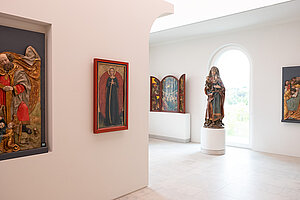Ecclesiastical art and cultural history in the Diocesan Museum

The Diocesan Museum on Freising Cathedral Hill aims to inspire its visitors with exhibitions on the history of art and culture at the intersection of faith, art and society.
The Diocesan Museum's collection comprises over 40,000 objects from all areas of ecclesiastical art and culture. It is one of the largest museums of religious history in the world. The main focus is on late medieval ecclesiastical art from Old Bavaria, Swabia and the Alpine region, as well as art-historically significant works from the South German Baroque and Rococo periods, but also artefacts from the fields of liturgy, popular piety, pilgrimage and monastic culture. Another area of the collection is formed by 2,700 objects of early Christian and Byzantine art and culture, which can be used to illustrate the origins of Christian art and liturgy in a separate exhibition area.
Let yourself be inspired and inspired by masterly works of art
The display collection presents Christian art from two millennia on almost 2500 square metres of exhibition space: from early Christian works to contemporary positions of the 21st century. In addition to 15th century Bavarian late Gothic artists such as Erasmus Grasser, Jan Polack and Gabriel Angler, the great Lucas Cranach and many Baroque and Rococo masters, such as Ignaz Günther, Johann Baptist Straub and the Asam brothers, are also represented.
New department since April 2025
The Munich collector and art dealer Christian Schmidt, who died in 2023, bequeathed ‘2,927 things’ to the Diözesanmuseum. The overwhelming wealth of Byzantine objects ranges from tiny gemstones to monumental sarcophagus reliefs, from outstanding works of art, including one of the oldest surviving processional crosses in the world from the fifth century BC, to fascinating everyday objects. The collection introduces visitors to the art and history of the Byzantine Empire, demonstrates its relationship to the Western Christian tradition and at the same time raises questions about the provenance and history of objects. Since April 2025, the two rooms set up specifically for this collection on the ground floor have formed the prelude to the tour of the permanent collections at the DIMU.
Contemporary art
Contemporary artists also have their permanent place in the new Diocesan Museum and ensure openness on all sides - such as the US installation artist James Turrell, who has created a light room in the former house chapel: "A CHAPEL FOR LUKE and his scribe Lucius the Cyrene" is a cross-room light installation in the form of a full field. Here, all architectural features - light, colour and space - merge into one, creating the phenomenon of a complete loss of depth perception. Upon entering the work, the boundaries of space and time are thus seemingly dissolved, creating proverbial delimiting experiences. The permanent installation by James Turrell is daily open from 10 to 11.30 am and 2.30 to 4 pm. Due to the high number of visitors, please allow for longer waiting times if necessary. (Due to events, the light installation will not be accessible on the following dates: 29 November 2025 in the afternoon, 6 December 2025 in the afternoon, 7 December 2025 in the afternoon, 13 December 2025 all day, 14 December 2025 in the morning, 21 December 2025 in the morning)
The Belgian sculptor Berlinde de Bruyckere took a particular interest in the museum's stock of late Gothic sculptures and, under this impression, created the larger-than-life bronze sculpture ARCANGELO for the atrium of the DIMU. The photographer Michael Wesely, known for his long exposures, shows the transformation of the museum in the last nine years in his two works, in which he let the museum team merge into one face shortly after the closure and shortly before the reopening.
During her visit to the Domberg in June 2019, the American artist Kiki Smith decided to design a small sacred space in the museum's outdoor area. The chapel she designed in collaboration with Brückner & Brückner is entitled "Mary's Mantle". It was built on the west terrace of the museum from April 2023 and designed by the artist (scroll down for more information and pictures).
Insights into the exhibition collection
Kiki Smith: Mary’s Mantle Chapel
A special work of art has been created in the north-west corner of the Diocesan Museum: The Chapel of Mary's Mantle. The chapel was designed by American artist Kiki Smith in collaboration with Brückner & Brückner Architects. Dedicated to the Madonna of the Protective Mantle, it has become a wonderful place for contemplation, a space of silence and refuge.
Gallery Mary´s Mantle Chapel
Freising Diocesan Museum
Contact
Diözesanmuseum Freising
Domberg 21
85354 Freising
General enquiries:
Phone +49 89 2137 74240
Mail info@dimu-freising.de
Booking enquiries:
Phone +49 89 2137 74369 (Tuesday to Thursday 9 to 11 a.m.)
Mail kunstvermittlung@dimu-freising.de
Web https://www.dimu-freising.de
Opening hours
Tuesday to Sunday from 9 am to 5 pm
Christmas opening hours:
Closed on 24, 25 and 31 December 2025; open on 26 December 2025, 1 and 6 January 2026
Admission prices
You can find an overview of the various admission prices on the museum's website (German only).
Barrier-free
The entire museum is either step-free or accessible via lifts. Further information on accessibility and a building plan are available on the museum's website (currently available in German only).
You can get to the Diözesanmuseum with the Dombergbahn. This connects the city centre from Bahnhofstraße with the Domberg without barriers and is located directly on the corner of Bahnhofstraße and Brunnhausgasse. Further information here on the website.
Parking
The parking garage on the Domberg is available. Access by bus is not possible. Please check our website for information about parking and bus stops.
Exhibitions
Information on current exhibitions at https://www.dimu-freising.de/ausstellungen/aktuell (currently available in German only).
Programme
Flyer for the quarterly programme from October 2025 to January 2026 (in German only)
